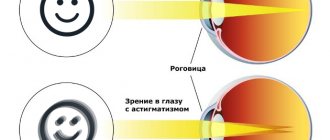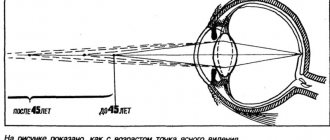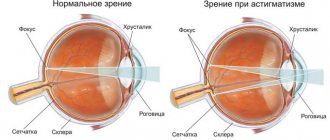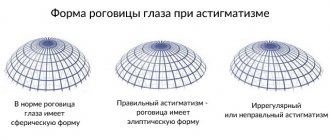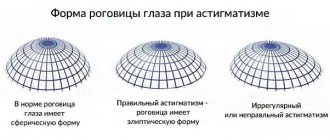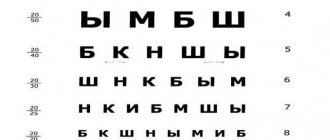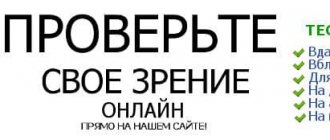Experts call astigmatism an abnormality of the eye, which consists in the fact that the radius of curvature of the cornea in different meridians is not the same. That is, in patients suffering from this disease, the focusing of rays on the retina of the eye is impaired, which leads to image distortion. Most often, the disease is caused by an irregularly shaped cornea. Treatment of this disease with lenses is currently not only very popular, but also quite effective. Astigmatic contact lenses perform the same function as glasses, namely, they refract and focus light rays for a better picture. When choosing this type of lenses, consultation with an ophthalmologist is necessary. It is worth considering that there are several types of contact lenses for astigmatism correction and each has its own advantages.
Types of contact lenses for astigmatism correction
Currently, manufacturers offer a large selection of contact lenses for patients suffering from astigmatism. Such lenses are called toric and differ in type and material. Soft contact lenses are made of polymer material. In order for these lenses to combat astigmatism, they are made of a special toric shape. Such lenses have two axes with different optical powers. They maintain a constant position corresponding to the position of the strong and weak meridians of the eyes. Due to this, visual acuity increases. Soft toric lenses differ in how they are worn. It is recommended to throw away daily lenses at night and put on a new pair in the morning. Extended wear contact lenses can be used around the clock for 2-4 weeks. The most popular are soft lenses from PureVision and Air Optix (Pew Vision and Air Optics).
The second type of lenses for treating astigmatism is rigid. These lenses are either regular or gas permeable. The former are not recommended for use, because they practically do not allow oxygen to pass through, and therefore, corneal edema is possible. Gas permeable lenses have the highest degree of oxygen conductivity among all existing types of lenses. Due to their structure, they are able to correct moderate astigmatism, even if they are of a regular shape. For more serious stages of the disease, experts recommend contact lenses with a toric surface. These lenses are worn only during the day. Unlike soft lenses, hard lenses retain their shape better and do not bend.
Lenses for astigmatism
Astigmatism is one of the vision problems that affects every fourth inhabitant of the planet. Some people simply don’t notice it, others get used to distorted and blurry vision, and others turn to specialists for help for diagnosis and subsequent vision correction. What is astigmatism? What are the differences between contact lenses for astigmatism? What developments do leading brands have in this area?
How do people with astigmatism see?
In the Greek word “astigmatism” - “stigma” is translated as “point”, the particle “a” is negation. The inability of the eye to focus vision normally is called astigmatism. When a light beam is focused on the retina at one point, we see clearly. If, due to deformation of the lens or cornea, several focused points appear, the image is blurry.
With astigmatism, a person sees objects at different distances in a blurred form or stretched either vertically or horizontally. To imagine this, just look at your reflection in a tablespoon. The closer the eye shape is to an oval, the greater the distortion, indicating pronounced astigmatism. Without special lenses for astigmatism, reading, working on a computer, driving a car, or simply looking at prices in a store can lead to eye strain and headaches.
Regular lenses and lenses for astigmatism. What is the difference?
These two types of lenses differ in their structure. Conventional lenses have a spherical shape and there is no significant difference in exactly how they should be positioned on the eye, since their action is the same in any meridian. Contact lenses for astigmatism can be compared to a ball that has been squeezed on both sides. In a normal position its shape is spherical, and in a compressed position it is toric. The curvature of the surface is where it is compressed more and the refraction is stronger than in other meridians. This is what contact lenses for astigmatism look like. And since they have two optical powers at the same time, the accuracy of their location on the eye is extremely important.
The lens must be placed according to the laser marks applied by the manufacturer. One part of the lens corrects astigmatism, and the other part corrects the accompanying pathology: myopia or farsightedness. Using special mechanisms, the lens is fixed so that it does not move when moving or blinking. Lenses for astigmatism are made from the same materials as regular soft lenses - hydrogel and silicone hydrogel.
Overview of lenses for astigmatism
Well-known manufacturers offer contact lenses for astigmatism with various wearing modes and replacement periods. You just need to choose a model in accordance with your individual parameters and preferences.
1-DAY ACUVUE® MOIST® for ASTIGMATISM
Soft and thin contact lenses 1 DAY ACUVUE MOIST for ASTIGMATISM from Johnson & Johnson, the world's leading manufacturer of contact lenses, are designed to correct vision in people suffering from astigmatism.
Contact lenses worn daily are a guarantee of safety and health. Lens replacement occurs before deposits form on its surface, and this factor is especially important for astigmatism.
The unique design of the lens - ASD, a special development of Johnson & Johnson, implies a clear fixation of the lens on the eyeball, preventing it from moving. No matter what position you are in or what you are doing, the toric lens stays in position even under increased eyelid pressure. And it is this factor that provides clear and clear vision with astigmatism. In addition, 1 DAY ACUVUE MOIST for ASTIGMATISM lenses are equipped with ultraviolet protection - harmful radiation that negatively affects the retina.
The benefits provided by Johnson&Johnson lenses are noticeable literally from the first day of wear. Increased comfort, ease of wearing, special stabilization, increased humidity and high oxygen throughput - these are the main advantages of 1 DAY ACUVUE MOIST for ASTIGMATISM.
ACUVUE® OASYS® for ASTIGMATISM
ACUVUE OASYS for ASTIGMATISM contact lenses are produced by the American company Johnson & Johnson, specializing in the development and production of vision correction products.
Created specifically for people prone to rapid eye fatigue, ACUVUE OASYS for ASTIGMATISM - super smooth lenses provide absolute comfort and ease of wearing. Almost imperceptible on the eyes, they have a perfect fit on the eyeball thanks to the unique ASD technology. The “Accelerated Stabilization Design”, developed specifically for astigmatic lenses, promotes a constant and stable position of the lens on the eyeball. Whether you're playing sports, lying on the couch or shopping, the lens remains stable regardless of head or eyelid position.
ACUVUE OASYS for ASTIGMATISM belong to the class of lenses for scheduled replacement. You can use them for two weeks up to 12 hours a day, placing them in a special solution overnight for storage and disinfection. Two weeks of comfort thanks to high levels of moisture and oxygen permeability, two weeks of maximum UV protection and clear, stable vision - all thanks to ACUVUE OASYS for ASTIGMATISM lenses.
Focus Daily Toric
Focus Dailies Toric from CIBA Vision Corp is the world's first daily toric soft contact lens designed to correct astigmatism. CIBA Vision Corporation was the first in the world to produce astigmatic lenses. Of course, over the years the basic design has undergone some changes - for example, the moisture content has increased from 58% to 69%, but the reliability of the design continues to please us to this day.
The Nelfilcon material from which Focus Dailies Toric is made belongs to the class of hydrogels with a high water content. Resistance to dehydration, that is, to drying out, makes these lenses extremely comfortable to wear and provide comfort even in rooms with dry air. The Aqua Comfort Plus three-level humidification system ensures the presence of moisture both on the surface of the lens and inside it.
Changing your contact lenses daily is the key to impeccable cleanliness and freshness, which means health and ease of wearing. The lenses are recommended for people leading an active lifestyle, including car drivers who spend long periods of time behind the wheel, as well as for irregular wear and as the first trial lenses for the correction of astigmatism.
Air Optix for Astigmatism
The second category of astigmatic lenses from CIBA Vision Corp is the Air Optix for Astigmatism extended wear period. Designed for daily use for 1 month, Air Optix for Astigmatism will make you forget about discomfort or redness and provide amazing wearing comfort. Absolutely invisible, ultra-thin, with a soft rounded edge, they are created specifically for people with increased sensitivity to contact lenses.
These lenses have a traditional toric shape that regulates vision correction for astigmatism. The revolutionary silicone hydrogel material allows seven times more oxygen to pass through than conventional lenses. This extraordinary gas permeability makes the Air Optix for Astigmatism one of the most comfortable long-wear lenses in its class. The perfect fit ensures excellent correction and prevents the lens from shifting throughout the day, and special orientation marks on the lens will help you position the lens correctly on the eyeball. The resistance of the Lotrafikon A material, from which Air Optix for Astigmatism is made, to various biological deposits protects the health and beauty of your eyes, and its high hydrophilicity guarantees comfortable wearing throughout the month.
SoftLens Toric
Bausch+Lomb presents its products for the correction of astigmatism. First of all, these are SoftLens Toric - lenses for the correction of astigmatism for a long period of wear. To be replaced once a month, they guarantee excellent, clear and precise vision.
The Lo-Torque design developed by Bausch+Lomb specifically for these lenses ensures the absence of distortion and splitting - the main scourge of people suffering from astigmatism. The toric shape of the lens allows you to concentrate the beam at one point, which guarantees stability and clarity of vision. In addition, the applied Lo-Torque design promotes the free exchange of tear fluid not only on the outer surface of the lens, but also between the edge of the lens and the eyeball, that is, in the so-called sublens space. Such circulation is designed to ensure wearing comfort and the absence of dry eye syndrome. In turn, this has a positive effect on eye health. Well, the hydrogel from which SoftLens Toric lenses are made is extremely resistant to the formation of plaque and biological deposits. Thanks to this technology, these lenses can be worn for up to 12 hours a day with regular monthly replacement.
Pure Vision 2HD for Astigmatism
Pure Vision 2HD for Astigmatism lenses, presented by Bausch+Lomb, are an innovation in the world of contact lenses for people with astigmatism.
The abbreviation HD is familiar to everyone - High Defenition means high image quality. And Pure Vision 2HD for Astigmatism lenses fully meet the quality stated in the name. The absence of glare and distortion, the ability to see in low light without excessive eye strain, the absence of a halo - a blurry and cloudy halo around light sources, guaranteed focus stability during sudden movements - all this is Pure Vision 2HD for Astigmatism from Bausch&Lomb.
The minimum thickness of the lens itself - in the center it does not exceed 0.1 mm - promises amazing comfort and ease of wearing. Softly rounded edges guarantee no discomfort or pain even when using the lens for 12 hours. 100% safety, no fatigue and dryness, high oxygen permeability, perfect fit and inability to move during movement, clear, full-fledged vision correction - all this has made Pure Vision 2HD for Astigmatism lenses one of the most popular in the world.
Soft contact lenses for astigmatism are in demand because they make it possible to see the world through different eyes and lead a more active life.
all articles
Lenses for astigmatism. What are the benefits?
Treatment of astigmatism with contact lenses has many advantages, because today toric lenses are made of silicone hydrogel and hydrogel material, which is perfectly perceived by the cornea. Plus, each patient, depending on his physiological characteristics and lifestyle, can choose the wearing mode that is convenient for him. These lenses also have a special locking mechanism that allows you to hold the lenses in one position. They are resistant to drying out, have excellent oxygen permeability, and the adaptation period lasts much less than with glasses. Toric lenses provide a high degree of clarity of vision and fit tightly to the eyes, forming one optical system with them.
Benefits of contact lenses for astigmatism correction:
- minimal viewing restriction and high image clarity;
- optimal conditions for lateral vision;
- minimum prismatic effect;
- perfectly moisturizes the eyes;
- allow the maximum amount of oxygen to pass through;
- increase visual acuity.
Factors influencing the selection of optics
When astigmatism is detected, the ophthalmologist determines the defect and the degree of deterioration in visual acuity - without this it is impossible to prescribe a correction. All research results are reflected in the recipe.
- Optical correction power - that is, actual visual acuity. In the prescription for optics it is indicated in diopters, which can be either positive (for farsightedness) or negative (for myopia).
- The radius of curvature is the curvature of the cornea. Reported in millimeters as the Bc value.
- Corneal diameter is the actual size of the cornea. Indicated in millimeters for the Dia value.
- Astigmatic correction power, that is, the visual reflection of the defect. Calculated in diopters, it can be either positive (hypermetropia) or negative (myopia). In the optics prescription it appears as Cyl.
- The location of the defect, that is, the location along the main meridian. Indicated in degrees corresponding to the inclination of the cylinder, which is determined by the Ax value.
- The type of stabilization is a method that will ensure that the position of the CL is maintained. Reflected in the recipe as Design.
Important! In most cases, in the prescription for TCL, the doctor indicates not only the above values, but also the manufacturer. This greatly simplifies the further purchase of corrective optics.
Choosing the duration of wearing TCL
In addition to the main characteristics of the optics, the duration of wearing contact lenses is also determined. Depending on the financial capabilities, physiological and anatomical characteristics of the patient, his habits and lifestyle, the duration of wearing is selected:
- daily – for single use during the day;
- planned replacement - wearing a TCL for 30-90 days (antiseptic treatment of the optics is required);
- frequent scheduled replacement - use of a set of optics for 7-14 days with mandatory antiseptic treatment during the period of non-use.
Important! The cost of using contact lenses for astigmatism practically does not depend on the duration of wearing one set. This should be taken into account when choosing optics.
How to choose contact lenses for astigmatism?
Selecting toric lenses is considered difficult. During the examination, it is necessary to determine not only standard parameters - optical power, radius of curvature of the cornea and diameter. It is also important to set the force values of the cylinder and its axis. It is not always possible to choose complex lenses correctly the first time. Sometimes the patient has to undergo several examinations.
In addition, you need to choose a method for stabilizing the contact optics. Conventional spherical and aspherical lenses shift when the head is tilted or the body position changes. This does not affect the quality of the correction. Toric products must remain in one position. Only in this case will they be able to compensate for astigmatism and one of the associated pathologies.
Vision and corneal parameters are determined using standard ophthalmic procedures. Among them:
- Visometry - checking visual acuity using tables.
- Autorefractometry is an assessment of the eye’s ability to refract light rays. The autorefractometer used in the examination allows you to obtain the most accurate data about the cornea.
- Biomicroscopy and ophthalmoscopy are diagnostic methods by which the condition of the fundus, vitreous body, and retina is studied.
The condition of the tear film may also be assessed. Its results will show which lenses with which moisture content are most suitable for the patient.
After calculating all the parameters, toric lenses are tried on. Clinics should have a database of diagnostic disposable models. If there are no complaints from the patient, the doctor writes a prescription for contact optics. Lenses with which stabilization method should I choose? The most modern are two methods:
- Accelerated stabilization. Two stabilizing centers are located on the inner and outer edges of the product. This is how ACUVUE Oasys for Astigmatism and ACUVUE Moist for Astigmatism lenses are stabilized.
- Prismatic ballast method. There is a thickening at the bottom of the lens that holds it in the correct position. This stabilization method works in the PureVision 2 HD for Astigmatism and Biomedics toric models.
These ophthalmic products do not shift even during intense physical activity. You can play sports in them.
Two weeks after purchasing toric contact lenses, it is recommended to return to the eye doctor for a follow-up examination.
Flaws
Toric contact lenses are considered the most effective way to correct astigmatism. Does it have any disadvantages? Perhaps we can highlight the following minor “cons”:
- Astigmatic lenses are difficult to fit. However, glasses for this refractive error are also complex means of correction. But correctly selected contact optics of a toric shape provide clear vision even with a high degree of astigmatism.
- There are contraindications for toric lenses. They do exist, but most of them are not absolute.
- Toric products change the shape of the cornea. Any means of contact correction affect the cornea. However, these changes are minor. Moreover, the cornea takes on a natural shape if you do not wear lenses for 2-3 days.
Key Advantage
What do specialists have that their competitors – retailers – cannot provide to the end consumer? Of course, high-quality vision care service, especially in cases where the patient is classified as “complex” or “non-standard”. For those involved in the selection of contact lenses, working with special lenses today promises great prospects. And although, unlike popular spherical soft contact lenses (SCLs), they are not so easy to select (more effort, knowledge and experience are required from the specialist), it is this work that helps to cultivate loyalty in patients, which then keeps them from purchasing lenses from third-party sellers .
Thus, optometric practice is quite capable of continuing to increase the number of its loyal clients due to its willingness to work with toric and multifocal lenses, and sometimes with both “in one person” (there are patients with complex problems). In addition, some complex cases require the use of corneal and scleral rigid gas permeable (RGP) lenses, as well as hybrid lenses. In the selection of materials below, all these options are presented in more detail.
This article is the first of three that examine various non-standard situations in contact vision correction. We'll discuss why a conscientious approach to correcting astigmatism and presbyopia helps win both the appreciation of many patients and their commitment to a particular optometrist's office.
Precautionary measures
How to protect your eyes from various adverse factors associated with wearing toric contact lenses? When using contact optics of any type, the following rules should be followed:
- Select lenses with your ophthalmologist. You cannot go to a store and buy the first model you come across without first examining it. Incorrectly selected products will not provide complete vision correction.
- Take care of your contact lenses. If you are wearing a planned replacement model, treat it with a special solution each time you remove it. Improper care can cause infectious or inflammatory eye diseases.
- Follow the wearing regime. If you do not do this, the risk of developing hypoxia increases. You should not sleep in lenses that are not intended for extended use.
- Do not wear products after their expiration date. Over time, the lens material deteriorates. This affects their optical properties.
If you follow these simple rules, then no complications, eye discomfort or other problems will arise when wearing toric lenses.
Using contact lenses for astigmatism is very convenient and safe. Modern technologies allow you to wear lenses both day and night, because they are of high quality material and have a wide range of advantages. Before purchasing lenses for the treatment of astigmatism, you must consult with an ophthalmologist, and, taking into account all the individual physiological characteristics and the degree of the disease, the specialist will select the required type of lenses. If you have already done this, then we recommend that you familiarize yourself with the wide range of contact lenses in our online store MagazinLinz.ru.
MagazinLinz.ru team
Tags: Air Optix Pure Vision Lenses for a month Articles Toric lenses
Patients with presbyopia
Types of lenses for presbyopia correction
An increase in the number of loyal clients of an optometric practice is also facilitated by the specialist’s willingness to deal with the correction of presbyopia. The fact is that patients with age-related changes in vision are “difficult to please” with the help of conventional spherical lenses, unless we are talking only about such a method of vision correction as monovision. With monovision, as is known, ordinary spherical lenses are used, only in a special way: a lens for distance is selected for the dominant eye, and a lens for near is selected for the other eye. True, such different simultaneous corrections do not allow one to achieve binocular vision, which is essential, for example, when driving a car.
In view of this, it is more preferable to wear multifocal contact lenses, in which it is possible to see at far, near and intermediate distances with both eyes. Because these lenses have a fairly complex design, fitting them is a longer and more expensive process than with single vision lenses. Adaptation to multifocal lenses sometimes also requires patience from the user, since objects may not immediately acquire clear outlines. However, the result is worth the effort, because as a result the patient does not require any glasses, including for reading, and he can enjoy freedom of movement for many years during outdoor activities, sports and other activities.
In developed countries, it has long been observed that users of special contact lenses are long-term patients, who also tend to recommend their specialists to a large number of people they know. And yet, many optometrists are still hesitant to begin working with such lenses. A 2015 Gallup study on multifocal contact lens use in the United States found that 42% and 38% of patients ages 40 to 54 and 55 to 64, respectively, expressed some interest in using such lenses. Despite this, multifocal lenses make up less than 20% of fittings during the work of about 91% of practitioners. Only 15% of them enthusiastically recommend these lenses to their patients, and 48% warn about the disadvantages of multifocal lenses even before they start wearing them.


